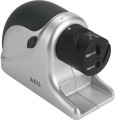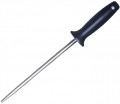Type
-
Stone. It is also a “sharpening stone” or “touchstone”. The simplest type of sharpener, used since prehistoric times: a block of abrasive material, along which a knife applied at the desired angle is passed during the sharpening process. Modern stone sharpeners can be equipped with various additional devices: stands, protective covers for storage and transportation, compartments for auxiliary accessories, etc. However, sharpening on such devices is carried out strictly by hand, and the angle usually also has to be controlled “by eye”. This, on the one hand, requires certain skills, on the other hand, it allows you to choose the angle at your discretion, which can be especially useful for some non-standard types of sharpening. In addition, due to their simplicity, stones are inexpensive, and due to their large sizes, they last quite a long time.
—
Manual sharpener. Devices for sharpening knives, held in the hands while working (however, there are models with stands that allow you to place them on a table or other suitable surface). A distinctive feature of many manual sharpeners is the characteristic groove into which the knife is inserted when sharpening. Inside the groove there is a pair of abrasive pads located at an angle optimal for sharpening. Thus, the user only needs to move the knife in the groove several times, holding the blade vertically - the desired cutting angle will be provided by
...the design of the sharpener itself. Many models of this type have several grooves that differ in roughness and other processing features. There are other options - for example, with the Lansky sharpening system (see “System”). Be that as it may, a manual sharpener will be the best choice for infrequent household use - for example, periodic sharpening of kitchen knives.
— Pocket sharpener. In accordance with the name, pocket sharpeners are small in size, allowing you to easily carry such a product with you. Some of them are also equipped with additional devices for ease of carrying - for example, a chain for hanging as a keychain. But the design of pocket models may be different. For example, some of them have grooves for sharpening, similar to manual sharpeners (see above); others open like a butterfly knife, only instead of a blade, a small sharpening stone comes out of the handle; still others have a “dog bone” type design, in the form of a rod made of abrasive material with protective and decorative linings at the ends, etc. In any case, a pocket model will be indispensable if you often have to be away from home and need to have a sharpener at hand - for example, on a camping trip or fishing (many models are suitable for sharpening hooks, see below). Of course, the capabilities of such products are noticeably more modest than those of larger analogues, and the quality of work is lower; but for express sharpening in the field this is quite enough.
— Power machine. An advanced type of modern electric sharpeners: functional designs that allow you to configure many additional sharpening parameters and/or significantly speed up the process. However, the main distinguishing feature of the machine is the presence of a base for installation on a horizontal surface - such devices are not suitable for holding in the hands. Power machines, as a rule, use replaceable sharpening stones, have adjustable sharpening angles, and sometimes have special operating modes.
— Stone for the sharpening system. Granular abrasive bars used as replacement attachments in certain sharpening systems such as Lansky or Apex (see “System”). Sharpening stones come in different types and grits. Typically, coarser stones have larger abrasive particles - they are designed to remove significant defects and restore sharpness. Fine abrasive stones are used for finishing sharpening of products and creating a finer edge.
— Professional sharpening machine. Specialized equipment designed for sharpening cutting tools. Professional-class models provide increased sharpening accuracy, provide a variety of flexible settings, and use various types of abrasive materials. Some professional machines may be automated and have control programs to provide more accurate results. Such models are not cheap, so for ordinary home use it hardly makes sense to purchase them. But if you have to sharpen often, in large quantities, and different types of blades (for example, in a tool sharpening workshop), such a device will be the best choice.
— Musat. Strictly speaking, musat is not a sharpener in the full sense. Its purpose is not so much to remove material from the edge of the knife, but to straighten it - to eliminate irregularities and burrs. This procedure does not replace full sharpening, but it still allows you to keep the cutting edge in working condition longer: the quality of work often deteriorates not so much because of the dullness of the knife, but because of deformations of the blade. And the musats still have some abrasive effect, slowing down the dullness. Externally, musat looks like a file with a round or oval shaft that tapers from the handle to the end; When working with such a rod, pass along the cutting edge several times. Note that the grinders are intended mainly for steel in the hardness range of 50 – 60 HRC: too much material will be removed from a softer blade (it’s easier to sharpen it in the usual way), and the grinder simply won’t work on a harder blade.Abrasive material
The main working material of the sharpener is the material that makes up the abrasive surface that provides processing.
—
Diamond (diamond coating). Diamond is the hardest of the well-known substances, which determined its key features — durability and high intensity of sharpening. At the same time, such an abrasive is not cheap, and the processing is rougher than that of many other materials. However, diamond surfaces are mainly used for roughing and semi-finishing, where the latter is not a disadvantage.
—
Ceramics. Ceramic materials, usually based on corundum — aluminium oxide. This material is softer than diamond, but still has a very high hardness (9 on the Mohs scale, only 10 higher for the same diamond). The performance of ceramic abrasives is slightly lower than that of diamond, but they provide cleaner processing and can be used at all stages of work — from rough sharpening to finishing — and are much cheaper.
—
Natural stone. Natural stone has been used to sharpen blades since prehistoric times, but has not lost its relevance to this day. The most popular varieties of this material are "Arkansas" and Japanese water stone (both named after their place of origin). At the same time, "Arkansas" is an extremely fine-grained and very pure quartz, and Japanese stone is silicon in connection with clay. All such materials are used only in
...stone sharpeners (see above). In general, they are able to provide a fairly high quality of sharpening, however, natural stone is rather “capricious” — in particular, the composition of even a very high-quality bar can be uneven, which can affect the quality of sharpening. And Japanese stones are also very demanding both for the procedure itself and for additional maintenance. However, natural stone sharpeners have their fans; many use such products not only because of their practical advantages, but also as a tribute to tradition or an element of a certain “knife culture”.
— Synthetic stone. A variety of abrasives obtained artificially and to some extent imitating the properties of natural stone. The composition and properties of such materials can be very different; usually, their quality is directly related to the price category of the sharpener. Anyway, synthetic stones (especially high-quality ones) often surpass natural counterparts in practical properties, but at the same time they are much cheaper. This is one of the most popular abrasives used in sharpeners of various levels and purposes. Note that in some cases, ceramics (see above) are also classified by manufacturers as synthetic stones; in such models, the abrasive material is indicated precisely according to the manufacturer's official data.
— Stainless steel. Steel, even with special additives to increase hardness, is a fairly soft material and has very low abrasive properties. Therefore, it is usually used for dressing knives, and most models of this material are musat (see "Type") or manual sharpeners operating on the same principle (the latter are actually two musat, fixed at an angle to each other).
There are quite a few models that combine different types of abrasives in their design — for example, diamond for rough processing and ceramic for fine grinding and finishing. Note that if the list of these materials includes a stone (for example, “diamond and stone”), then we are talking exclusively about synthetic stone, because. natural for a number of reasons is not combined with other materials.Serrated sharpening
Possibility of using a sharpener for
sharpening serrated blades.
Such blades have a serrated cutting edge, for which the classical method of sharpening, on a flat surface, is unsuitable: such a procedure will simply erase the teeth and, at best, turn the serrated blade into a classic smooth one. Therefore, for sharpening in this case, special devices are used: thin rods made of abrasive material, somewhat tapering towards the end. With such a rod, each individual tooth is sharpened separately; this work can be quite laborious, but it allows you to restore the full performance of the serrated blade. At the same time, note that for blades with fine teeth, even such a specialized sharpener may be too large.
Sharpening scissors
Possibility of using a sharpener for
sharpening scissors.
Technically, you can sharpen scissors on almost any sharpener — the design of their blades is not very different from knife ones. However, individual sharpeners may provide various design solutions that make it easier to work with scissors — for example, the ability to set the optimal sharpening angle or special mounts for such a tool. Therefore, for maximum convenience when working with scissors, you should still choose models where this function is directly stated.
Cover/case
Cover/case. Accessory for storing and transporting the sharpener, protecting the product from contact with surrounding objects, dust, moisture and other adverse factors. A cover can mean both a product made of soft materials and a small hard container for a compact model; case is usually called rather large boxes for advanced kits like machines (see "Type") or sharpeners such as Lansky (see "System"). Accordingly, the design features and the degree of protection may be different, the details should be clarified for each model separately. However, anyway, a complete case or case is much more convenient than an impromptu package.

